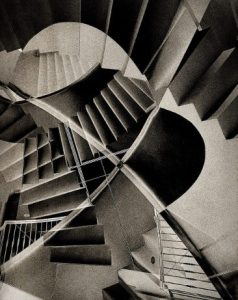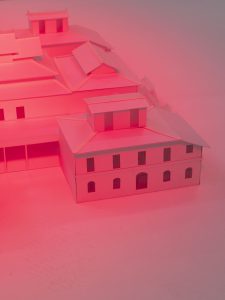הוזמנתי לדבר בכנס ” בעקבות קולם – אתגר הוראת השואה באמצעות עדויות במאה ה- 21″ על שאלות של אמנות ועדות שואה באמנות הישראלית העכשווית . הכנס נערך במשואה המכון הבינלאומי ללימודי השואה”, בקיבוץ תל- יצחק באמצע יוני בהשתתפות אנשי חינוך ואנשים המגבשים דפוסי זיכרון חדשים מפרופ’ מיכל גוברין, שעסקה בכך עם קבוצת מחקר במכון ון ליר ועד אנשי “זיכרון בסלון” גוף שצמח מחיפוש פרטי אחר אופן חדש לזכור.

בעשורים החולפים עמדו עדים במרכז גיבוש הזיכרון, במפגשים או כאנשי עדות שהתלוו במסעות לפולין. דור השורדים הולך ומתמעט ונוצר מצב חדש בו העברת הזיכרון תהיה ללא עדים.שאלות אודות הדרך בה אנו מבינים את העולם, אופני ייצוגו ואודות ריבוי המציאויות וקריאתן מעסיקות את העולם האמנות מעצם מהותו. עדות, האפשרות למסור עדות, מהו הקשב בו היא מתקבלת העסיקה ישירות אמנים כמו רועי מנחם מרקוביץ שהסריט את סבתו המספרת,המושתקת, המבוימת , את חוסר היכולת לגשר בין הווה לעבר.
אופן אחר הוא בחינה מהזווית של מה שאפשר בזהירות רבה לכנות כ reenactments , שיחזורים . שי שאול שיחזר את מבט הפרדה של סבו מבית מגוריו בברלין בתוך בית המגורים שלא נחרב במלחמה.

עומר פאסט הציג בעבודת הווידיאו ” רשימת שפילברג ב 2003 את היחס המצמרר בין מחנה פלאשוב האמיתי לשחזורו שנעשה עבור הסרט “רשימת שינדלר” ב 1993. ברומן המצויר “יחזקאל” של מיכאל קובנר אני מתבוננת בהרצאה ב”חיפוש אחר דרכי התמודדות חדשות – ייצוגי שואה באמנות ישראלית מאז תחילת שנות ה 2000″ שאתן היום בטקס השנתי להענקת פרסי הצטיינות לעבודות על השואה לשנת 2015. “יחזקאל” שייך למה שאפשר לתאר כמסורת שמתחילה בקומיקס השואה פורץ הדרך Maus של ארט שפיגלמן שראה אור כספר ב 1991 ובין ממשיכיה בארץ מישל קישקה. “הדור השני, דברים שלא סיפרתי לאבא”, ורותו מודן “הנכס”, ששניהם ראו אור ב 2013 .  הרומן המצויר של קובנר שונה בסגנון הציורי המובהק, שממשיך קרירה ארוכה שלציור פיגורטיבי וגם בכך שהטקסט הוא פחות המניע של ההתפתחויות. גם ההפיכה שלו למחזה , שבו הציורים מוקרנים כווידיאו יוצרים סיטואציה יחודית.
הרומן המצויר של קובנר שונה בסגנון הציורי המובהק, שממשיך קרירה ארוכה שלציור פיגורטיבי וגם בכך שהטקסט הוא פחות המניע של ההתפתחויות. גם ההפיכה שלו למחזה , שבו הציורים מוקרנים כווידיאו יוצרים סיטואציה יחודית.
קובנר, כמו קישקה ומודן מדברים על ההווה , על זיכרון שעובר דרך פילטרים אינסופיים בעולם שבו אנחנו יודעים שסיסמאות ה”לעולם לא עוד” שהופרחו בעבר לא עומדות במבחן המציאות . גנוסייד מובהק בקמבודיה,ברואנדה , במלחמות הבלקנים באירופה , או רצח המוני כמו בסוריה כיום מתרחש שוב ושוב וגם על עדויות השואה ומה שהוגדר בעבר כ”לקחיה” אנחנו מתבוננים דרכם, דרך התגובות להם.

הרשמה לניוזלטר הפירסומי השבועי של “החלון” בנושאי אמנות, אירועים ותערוכות חדשות – www.smadarsheffi.com/?p=925 (הרישום נפרד מהרישום לבלוג )
הערות/הארות אנא כיתבו ל thewindowartsite@gmail.com
לקביעת פגישת הדרכה פרטית לפני נסיעה לנוסעים וקבוצות עצמאיות שמתכננים לבקר בונציה על הביאנלה ותערוכות המוצגות במקביל כיתבו thewindowartsite@gmail.com
Some thoughts on the representations of Holocaust memory in art (from two recent lectures)
I was recently invited to give a lecture on issues of art and representations of memory of the Shoah at the Massuah Institute conference on the challenge of teaching the Holocaust in the 21st century through testimonies. The recent conference at Tel Yitzhak was attended by educators and others engaged in formulating new patterns of memory, from Prof. Michal Govrin, who led a research group at the Van Leer Institute, through Zikaron Basalon, a group which originated from one individual’s search for a new mode of memory.

Over recent decades, witnesses central to memory formation, at meetings or as “living witnesses” escorting educational groups to Poland. The survivor generation is dwindling, leading to a new situation in which the transmission of memory will have to be accomplished without firsthand witnesses. Questions about the way we understand and represent the world, multiple realities and how to read them, are engaging the world of art by its very nature. Testimony and its context has engaged artists directly, such as Roy Menachem Markovitch, who directed and filmed his silenced grandmother narrating her story, showing the inability to bridge past and present.

Another angle of exploration is through what can be cautiously called “reenactments.” Shai Saul reenacted his grandfather’s farewell gaze at his Berlin home by filming him in the apartment house that remained standing during the war. Omer Fast’s video, Spielberg’s List (2003) depicted the chilling relationship between the real Plaszów concentration camp and its recreation for the film Schindler’s List (1993).
In my lecture at the Massuah Instistute’s annual awards ceremony for outstanding Israeli art on the Holocaust, I take a closer look at Michael Kovner’s Ezekiel’s World, which belongs to what may be called a tradition that began with Art Spiegelman’s breakthrough “comics” Maus, a graphic novel on the Holocaust published in book form in 1991. Among those continuing this trend in Israel are Michel Kichka, with his “Second Generation: Things I never told my father” and Rutu Modan’s “The Property,” both published in 2013. Kovner’s graphic novel differs in its clear painterly style (rather than comics style),

continuing his long career in figurative painting, and the text being less important in moving the action forward. Transforming it into a play in which the paintings have become video projections create a unique situation.
Kovner, like Kichka and Modan, speaks of the present, addressing memory passing through infinite filters in a world in which we know that slogans of the past, such as “Never Again,” have not withstood the test of reality.
Join the mailing list for Window’s weekly informational advertising newsletter:
www.smadarsheffi.com/?p=925
Comments – please write to thewindowartsite@gmail.com






